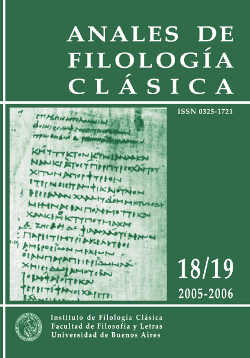Topografía y “topothesia” en los <i>Commentarii</i> de Servio: el caso particular de España
Palabras clave:
Servio, España, topografía, topothesia, historia, Servius, Spain, topography, history
Resumen
Tras la reestructuración de los límites del Imperio concluida en el siglo IV d.C., la presencia de España en el comentario de Servio a la Eneida de Virgilio es clave, ya que dista del imaginario de los escritores latinos contemporáneos a Virgilio e inmediatamente posteriores. Servio necesita definir la noción de lugares geográficamente existentes (topografía) para distinguirlos de aquellos que estaban en la imaginación de viajeros y poetas (“topothesia”).The new Imperial distribution operated in IV A. D modified the mental map of the Late Antiquity, and due to this Servius needs to redefine the notion of geographically existent places (topography) to separate them from those that lived in the imagination of the travelers and poets (topothesia) when writing his commentary to Virgil’s Aeneid. Consequently, Spain becomes an essential presence in the commentary, considering it differs from the topography of Virgil’s contemporary and immediately latter Latin writers.Descargas
La descarga de datos todavía no está disponible.
Cómo citar
Pégolo, L., Cardigni, J., Meardi, F., Ramírez, C., & Romero, U. (1). Topografía y “topothesia” en los <i>Commentarii</i> de Servio: el caso particular de España. Anales De Filología Clásica, (18-19), 109-124. https://doi.org/10.34096/afc.v0i18-19.440
Número
Sección
Artículos
Los autores/as que publiquen en esta revista aceptan las siguientes condiciones:
- Los autores/as conservan los derechos de autor y ceden a la revista el derecho de la primera publicación, con el trabajo registrado con la licencia de Atribución-CompartirIgual 4.0 Internacional (CC-BY-SA 4.0) de Creative Commons, que permite el uso comercial de la obra y de las posibles obras derivadas, la distribución de las cuales se debe hacer con una licencia igual a la que regula la obra original.
- Los autores/as pueden realizar otros acuerdos contractuales independientes y adicionales para la distribución no exclusiva de la versión del artículo publicado en esta revista (p. ej., incluirlo en un repositorio institucional o publicarlo en un libro) siempre que indiquen claramente que el trabajo se publicó por primera vez en esta revista.
- Se permite y recomienda a los autores/as a publicar su trabajo en Internet (por ejemplo en páginas institucionales o personales) antes y durante el proceso de revisión y publicación, ya que puede conducir a intercambios productivos y a una mayor y más rápida difusión del trabajo publicado (vea The Effect of Open Access).
En ningún momento se cobrará monto alguno al autor por la publicación en esta revista.







